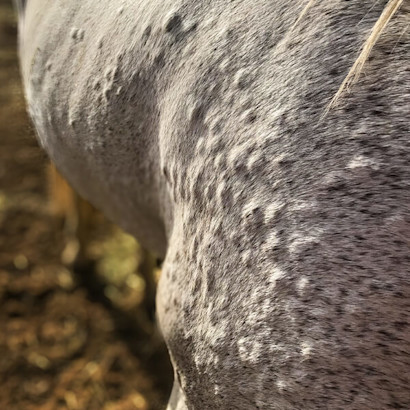Causes and Treatment for Hives in Horses
Updated July 15, 2025

Hives, also known as urticaria, are fluid-filled, raised swellings or “wheals” on a horse's skin. These bumps or plaque-like eruptions are generally round in shape and flat-topped, ranging from ½-inch in diameter to as large as 8 inches wide.
Signs and Symptoms of Hives in Horses
Hives in horses may or may not be itchy, appear minutes to hours to days after exposure, are often seasonal in nature, and can develop anywhere on a horse’s body, although the most common sites are the neck, back, flank, and legs.
A one-time occurrence that goes away on its own may not be a reason to pursue cause or treatment. However, hives that won’t go away, that go away and come back (recurrent urticaria), or that lead to oozing and crusting, secondary bacterial infections, or extreme discomfort to the point of anxiety, excitement, and restlessness should be investigated and treated.
Causes of Hives in Horses

What makes hives so challenging is that they can be caused by many things, such as:
- bug bites
- inhaled pollens
- ingested foods
- administered medications
- direct contact with various substances
- hot or cold temperatures
- pressure
- exercise
To try and pinpoint the cause of a horse's hives, the veterinarian will start with a thorough history from the owner. Obvious changes to the horse’s routine should be shared with the vet such as new bedding, pasture turnout, different shampoo, a change in hay or grain, new tack or other equipment, etc.
Often the first approach is to discontinue all new items, see if the horse’s skin recovers, then “challenge” the horse with one new item at a time each week to see if the hives return. If so, then this process of elimination worked. If not, then it may be time for more advanced diagnostics like allergy testing.
Some vets will refer their patients to a board-certified dermatologist or internal medicine specialist for intradermal skin testing, especially since most experts agree that it is more reliable than serologic (blood) tests at pointing out the specific substance causing an allergic reaction in an individual horse.
When food allergies are suspected, neither skin nor blood tests can be counted on to accurately identify what triggers an outbreak of hives – only a food trial or elimination diet can reliably provide that answer.
Treatment for Hives on Horses
A horse with hives can be made more comfortable with medications like steroids and antihistamines, supplements like omega 3 fatty acids and MSM, and skin care like cool rinses.
All attempts should be made to remove or reduce exposure to as many identified allergens as possible. For example, if insects have been found to be the culprit, then fly sheets, boots, and masks can be added to the horse; fans, mesh curtains, and a timed spray system can be added to the barn; and measures to limit the insect population like parasitic wasps, feed-through fly control, manure removal, and control of standing water can all be used.
If the horse still has hives – or the hives are due to one or more allergens that cannot be removed from the horse’s environment like tree or grass pollens or the Culicoides biting midge that causes “sweet itch” then it may be possible for the veterinary specialist to develop allergen specific immunotherapy or “allergy shots” or the more recent “allergy drops" which are placed in the mouth.
Ask the Vet Video on Pressure Hives in Horses
In this Ask the Vet video, Dr. Lydia Gray describes how pressure hives are diagnosed and treated by veterinarians.